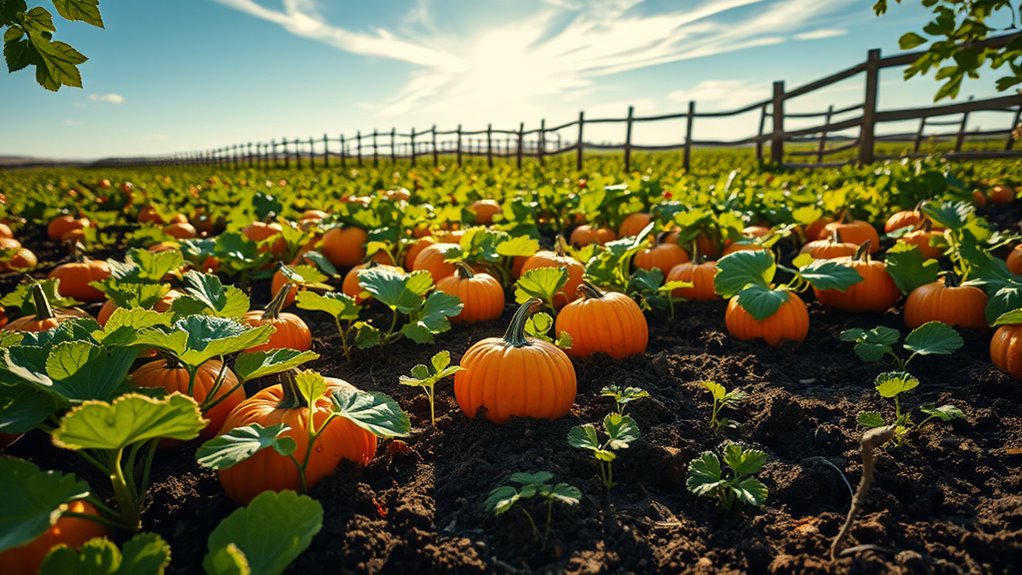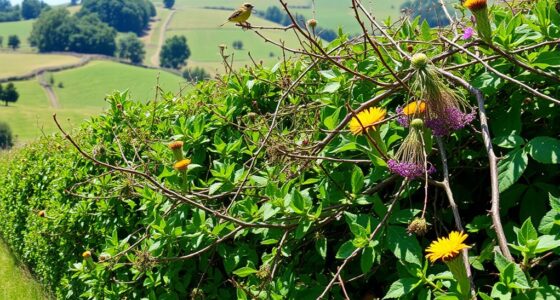To grow pumpkins from seed to harvest, plant your seeds from late May to early July in well-drained soil, ensuring the temperature's between 65°F and 95°F. Space seeds 2-5 feet apart and mix in aged manure for nutrients. Water about an inch weekly, and watch for vibrant color, a hard rind, and a shriveled stem to know when they're ripe. After harvesting, curing and storing them properly can extend their shelf life. You'll want to discover more tips for success!
Key Takeaways
- Plant pumpkin seeds between late May and early July, ensuring soil temperatures are between 65°F and 95°F for optimal germination.
- Space seeds 2-5 feet apart and plant them about 1 inch deep in well-drained soil enriched with aged manure or compost.
- Maintain consistent watering of about one inch per week, avoiding wetting the leaves and fruit to prevent disease.
- Harvest pumpkins when they have a vibrant color, hard rind, and shriveled stem, cutting them with a few inches of stem attached.
- Cure harvested pumpkins in a sunny spot for 10-14 days before storing them in a cool, dry place for up to 3 months.
When to Plant Pumpkin Seeds
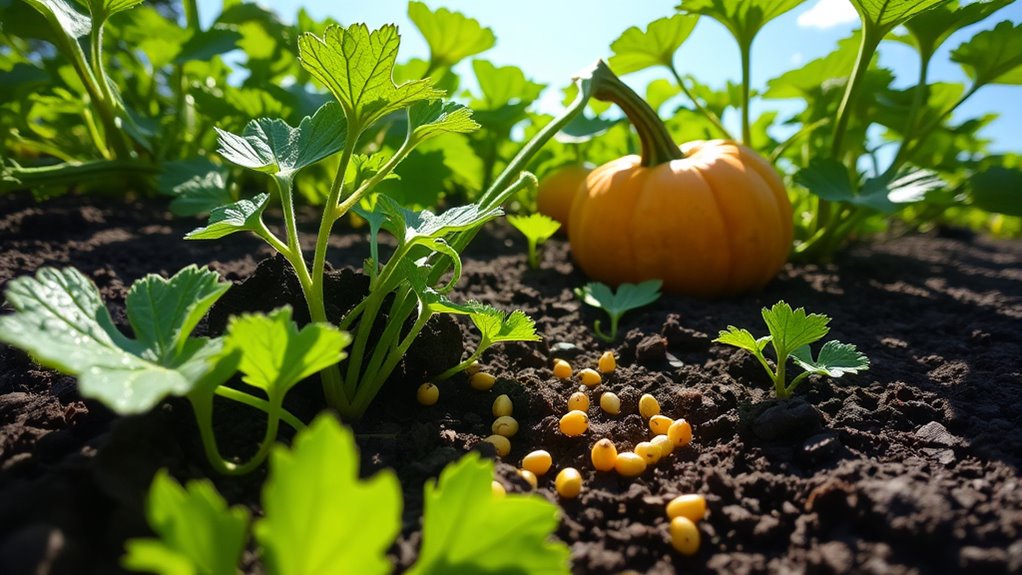
When it comes to planting pumpkin seeds, timing is essential to secure a bountiful harvest. You should aim to plant seeds between late May and early July, depending on your location.
Northern growers need to stick to late May, while those in the south can extend planting until early July. Keep in mind the days to maturity information: pumpkins typically need 90 to 120 days to reach maturity, so plan accordingly for an October harvest.
Northern growers should plant by late May, while southern growers can extend to early July for an October harvest.
For smaller pumpkin varieties like Early Sweet Sugar and Baby Bear, early summer is the best time to plant for ideal ripening.
Also, make certain the soil temperature is between 65°F and 95°F (18°C to 35°C) for successful germination. Happy planting!
How to Plant Pumpkin Seeds
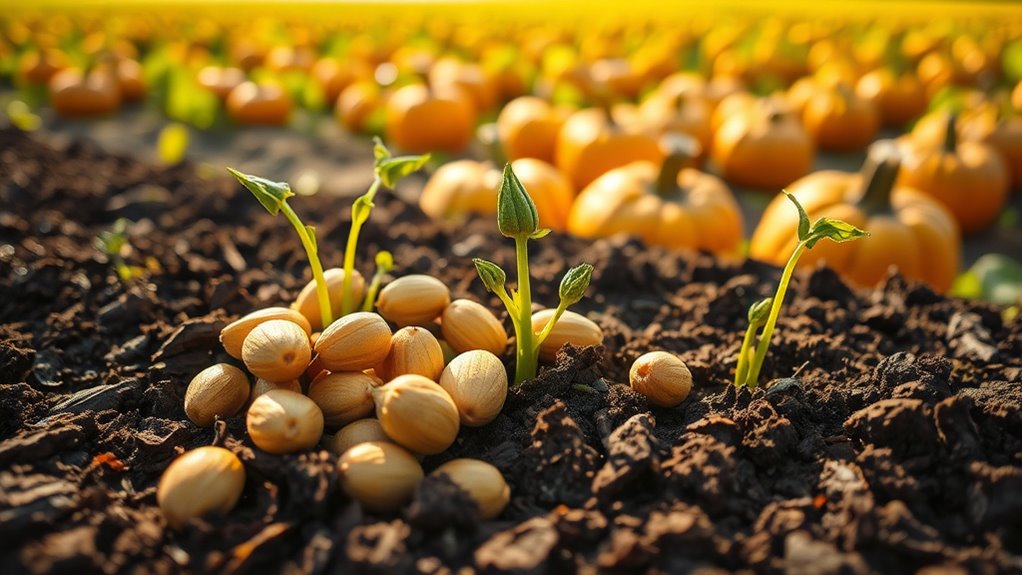
To successfully plant pumpkin seeds, you'll want to start them directly in well-drained garden soil after the last frost date, ensuring the soil temperature is between 65°F and 95°F (18°C and 35°C).
Here's how to prepare your pumpkin patch:
- Space seeds 2-5 feet apart, depending on the variety.
- Plant seeds about 1 inch deep.
- Mix aged manure or compost into the soil for nutrients.
- Consider mound planting with 3-5 seeds per mound for warmth and moisture retention.
Tips for Growing Pumpkins
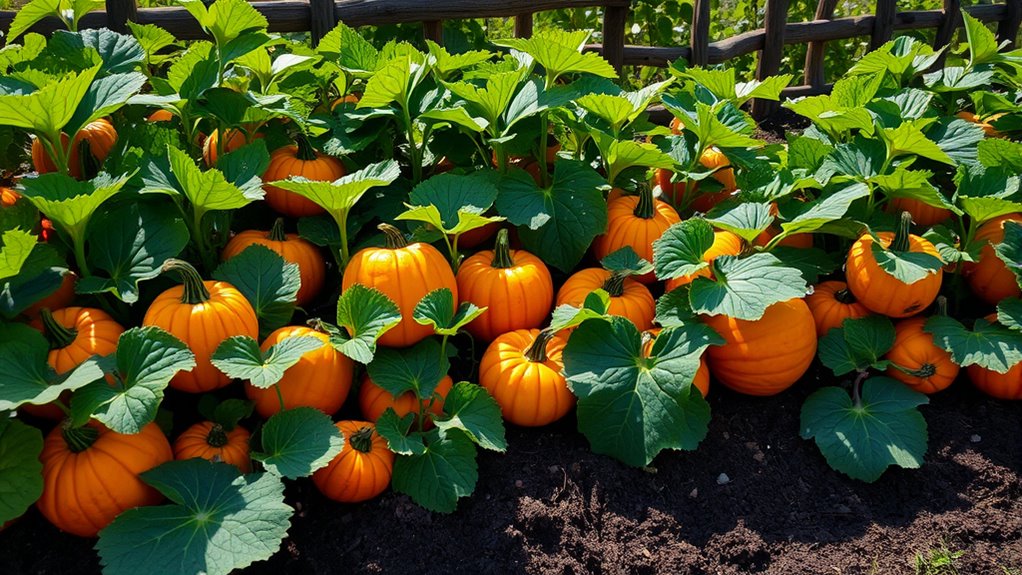
To grow healthy pumpkins, start with proper soil preparation, as it sets the foundation for strong plants.
You'll also need effective pest management strategies to protect your pumpkins throughout the growing season.
Let's explore how to guarantee your pumpkins thrive from the ground up.
Soil Preparation Importance
Proper soil preparation is essential for growing healthy pumpkins, as they thrive in well-drained soil with a pH between 6.0 and 6.8.
To guarantee your pumpkins get the nutrients they need, focus on creating nutrient-dense soil. Here are some tips to enhance your soil preparation:
- Incorporate aged manure and compost before planting.
- Mix one cup of complete organic fertilizer into the soil beneath each plant.
- Add mulch around the plants to retain moisture and suppress weeds.
- Monitor soil conditions and provide about one inch of water per week, avoiding wetting the leaves and fruit.
Pest Management Strategies
While growing pumpkins can be rewarding, managing pests effectively is essential for a successful harvest. Regularly inspect your plants for common pests like aphids and cabbage loopers. Implement crop rotation to prevent soil-borne diseases. Encourage natural predators such as ladybugs to control pest populations without chemicals. Hand-picking can also help reduce pest numbers.
Here are some effective pest management strategies:
| Strategy | Description | Benefits |
|---|---|---|
| Early Detection | Inspect plants regularly for pests | Prevents widespread infestations |
| Crop Rotation | Avoid planting pumpkins in the same spot yearly | Reduces soil-borne diseases |
| Natural Predators | Introduce beneficial insects like lacewings | Minimizes chemical use |
| Proper Watering | Maintain healthy soil moisture | Strengthens plants against pests |
Following these strategies will lead to healthier plants and a bountiful harvest.
Pumpkin Growth and Harvesting

As your pumpkins grow, you'll want to watch for signs of ripeness, like a vibrant color and a hard rind.
When it's time to harvest, use a sharp knife to cut the stem, leaving a few inches attached for better storage.
After you've picked them, curing your pumpkins in the sun will help enhance their shelf life before you store them away.
Signs of Ripeness
Determining when a pumpkin is ripe can be an exciting part of the growing process. To identify the signs of ripeness, check for these key indicators before you harvest pumpkins:
- Color: A ripe pumpkin typically shows a deep, rich color, often orange, depending on the variety.
- Skin: The skin should feel hard and resist puncture when pressed with your fingernail.
- Stem: A shriveled, dry, and brown stem indicates the pumpkin is ready for harvest.
- Sound: When you tap the pumpkin, a hollow sound suggests it has reached full ripeness.
Harvesting Techniques
Once you've confirmed your pumpkins are ripe, it's time to focus on harvesting techniques to guarantee a successful pick. Look for pumpkins that display a bright, deep color, a hard rind, and a shriveled, dry stem—these signs indicate ripeness.
To verify, thump the pumpkin; a hollow sound means it's mature. When you're ready to harvest, use a sharp knife for cutting the stem, leaving 3 to 4 inches attached to enhance storage longevity.
A few weeks before harvest, remove any leaves shading the pumpkins to improve their color and prevent rot. After harvesting, cure your pumpkins in a warm, sunny spot for 10 to 14 days to harden their skins and extend their storage life.
Post-Harvest Care
To guarantee your pumpkins maintain their quality after harvest, it's crucial to follow proper post-harvest care. Start by checking for ripeness—ensure the rind is brightly colored, hard to the touch, and the stem is shriveled.
When harvesting, cut the pumpkins from the vine with a sharp knife, leaving a 2 to 4-inch stem for better storage.
Next, cure your harvested pumpkins in a sunny spot for 10 to 14 days at temperatures between 80º to 85º F.
After curing, store them properly to prolong their freshness:
- Remove any leaves shading the pumpkins.
- Keep the pumpkins in a cool, dark place at 50º to 55º F.
- Monitor for any signs of decay.
- Enjoy your pumpkins for 2 to 3 months!
Curing, Storing, and Displaying Pumpkins

After you harvest your pumpkins, curing them properly is essential for enhancing their sweetness and extending their storage life.
Place your pumpkins in a sunny spot for 10-14 days at temperatures between 80º to 85º F and 80-85% humidity. This process helps them develop flavor.
Once cured, store your pumpkins in a cool, dry place at 50º to 55º F to keep them fresh for 2-3 months. Handle them gently during curing and storing to prevent bruising.
When displaying your pumpkins, consider decorative arrangements on porches or entryways. Just remember, avoid carving them more than 3 days before Halloween to prevent premature decay.
Enjoy your beautiful, sweet pumpkins throughout the season!
Pumpkin Trivia and Carving Tips

Have you ever wondered why pumpkins are such a beloved symbol of fall? These vibrant gourds have been cherished in North America for nearly 5,000 years, especially during Halloween.
Carving pumpkins is a fun tradition, but remember to carve them no more than three days before Halloween to avoid rotting. Here are some tips for selecting and carving your pumpkin:
- Choose a solid, even shape with a sturdy stem.
- Inscribe messages with a large nail for visible letters at harvest.
- Use a sharp knife for clean cuts and intricate designs.
- Consider the pumpkin's nutritional benefits for culinary uses.
With these tips, you'll enjoy a festive and fruitful pumpkin season!
Frequently Asked Questions
How Long Does It Take for Pumpkins to Grow From Seed to Harvest?
It takes about 90 to 120 days for pumpkins to grow from seed to harvest, depending on the variety you choose.
If you're planting smaller pumpkins, like Early Sweet Sugar, you'll see results sooner than with larger types, such as Dills Atlantic Giant.
For the best yield, plant your seeds between late May and early July.
Keep an eye out for bright color, a hard rind, and a shriveled stem to know when they're ripe.
Will Pumpkins Grow From Store-Bought Pumpkins?
Sure, you can grow pumpkins from store-bought pumpkins—if you're not too picky about what you get!
While it sounds easy, the seeds mightn't yield the same variety due to potential cross-pollination. Clean and dry the seeds, then plant them after the last frost.
If you choose the largest seeds, you'll have a better chance of growing stronger plants. Just remember, you might end up with a surprise pumpkin variety!
Do I Need to Dry Pumpkin Seeds Before Planting?
Yes, you need to dry pumpkin seeds before planting.
Drying helps prevent mold and boosts germination rates. After harvesting, wash the seeds to remove any pulp, then let them air dry on a paper towel for about a week.
Once dried, store them in a cool, dry place to keep them viable. Properly dried seeds can last for 3-4 years, so take the time to prepare them right for future planting.
What Is the Best Month to Plant a Pumpkin?
You're enthusiastic to plant your pumpkins, but timing is everything!
The best month to sow those seeds is between late May and early July, depending on where you live. If you're in the north, aim for late May to beat the frost.
In the south, you can push it to early July. Just remember, the soil needs to be warm enough for those seeds to thrive!
Get ready for a fruitful harvest!
Conclusion
Now that you know how to grow pumpkins from seed to harvest, it's time to get started! Did you know that the world's heaviest pumpkin weighed a staggering 2,624.6 pounds? Imagine growing your own giant pumpkin and sharing it with friends! With the right care and attention, you can enjoy a bountiful harvest and create lasting memories. So grab your seeds, follow these tips, and watch your garden transform into a pumpkin paradise!

